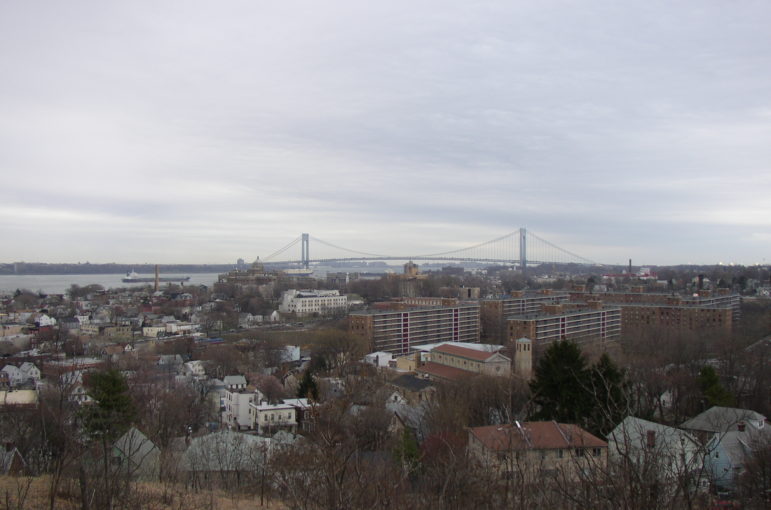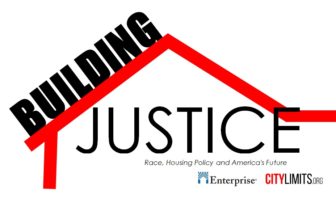
Wusel007
'The decision to set huge apartment complexes in the midst of Victorian homes and the small town centers of the North and East Shores of Staten Island—and not anywhere else in our borough—brought with it a seismic shift in neighborhood culture.'
A cascade of crises is forcing America to confront the racism of its past and present—from overt acts of hate to subtler injustices that shape our society. Over 16 weeks, City Limits and Enterprise Community Partners will feature prominent New Yorkers’ views on how race and housing policy intersect to create a legacy each of us must confront, and the way forward we should take together. These are not necessarily views we endorse. But they are views we fully believe are important to share with each other. Here is the fourth post in our series. Read the rest here.
* * *
Staten Island is America’s biggest small town. It is a characteristic that makes living on Staten Island a treasure. For decades, ethnic-identified communities have contributed the best of their culture, history, traditions, and strength of family. The Italians of Rosebank and South Beach. The Irish of West Brighton and Midland Beach. The Poles of Elm Park. The black communities of Sandy Ground and Manor Heights. More recently, newer waves of immigrants have also brought rich and diverse cultures to our island. The West African communities of Park Hill. The Sri Lankan, West Indian, and Albanian communities of Tompkinsville. Multiple Mexican communities thrive: initially found in Port Richmond, they stretched out, at first to South, Midland and New Dorp beaches, more recently, down to Tottenville. Similarly, the Russian communities of South Beach have expanded along our Verrazano Narrows and onto Raritan Bay shoreline. As the second-fastest growing county in New York State and with the highest percentage increase in new immigrant populations over the last decade, we are a newly- and deeply-diverse Staten Island, still doing the work of Miss Liberty.
Ethnicity is not the only characteristic that has defined our communities. Housing stock did. The historic Mud Lane houses of Stapleton. The Victorians of both our North and South Shore neighborhoods. The old style SROs of Port Richmond. The bungalows of our beach communities. Our turn-of-the-century town centers–still vibrant in many communities. Although a neighborhood’s housing stock knows no ethnicity or race, as a teenager I lived through the October 16, 1975, Milton Avenue fire-bombing of the new home of the Charles family, the first black family to purchase a home in New Dorp/Oakwood. Our parish took in the family at the time of that tragedy. It was a shocking event for all of us and one that turned a new page on defining who we were as a community.
We have come a long way. But we are battle scarred. And we have miles to go.
When the HUD and NYCHA housing projects were built in the 1960s (10 developments with a total of 4,500 apartments), the character of some of our borough’s neighborhoods radically changed. The decision to set huge apartment complexes in the midst of Victorian homes and the small town centers of the North and East Shores of Staten Island—and not anywhere else in our borough—brought with it a seismic shift in neighborhood culture. Large-scale, low-income housing instantly created profound economic and broad racial-ethnic shifts. As the social centers of the small neighborhoods surrounding the projects crumbled, white flight followed. We now have significant communities of color along our North Shore but, with the exception of Sandy Ground, very few elsewhere on our island.
Because past experience informs current understanding, for many on Staten Island, the phrase ‘low-income housing’ brings to mind visions of the large-scale projects and the social problems that came with institutionalizing poverty: street crime, loss of local control of our neighborhoods and racial fear. Decades later, as the city tries to address a serious housing crisis affecting all five boroughs by requiring that new residential developments set aside a share of their units for “affordable” housing, the “deep affordability” option (an income of $31,080 for a family of three) reignites the fears that new apartment complexes will turn into “the projects.”
Negative images from the past do not square with reality. Today, far too many Staten Island families, many with multiple breadwinners, cannot find affordable housing. No different from Staten Islanders living mid-Island or on the South Shore, they work and their children attend school. Understand how severe the housing shortage is: Following the privatization of the former Markham Gardens, Staten Island suffered a loss of 136 “deeply affordable” housing units. As the Staten Island Advance reported on July 26, 2016, since January 2014, only 438 new apartments have been added under the City’s affordable housing plan. Taking into account the previous loss of the Markham Gardens units, that is a net gain of only 302 units.At the same time, one non-profit legal organization reported a record 487 eviction cases on Staten Island in FY ’15-’16. And the phone rings off the hook at my office, with people desperately searching every day for “deeply affordable” rental units.
Our borough rightly rails against illegal house conversions, and quadrupled up families – a situation that puts families and firefighters’ lives at risk. But we need to open at least six deeply affordable apartments for every boarded up illegal conversion. No parent is happy about their whole family sharing a bedroom because that is all they can afford. The need for such affordable apartments for working Staten Island families is dire these days.
And as real-estate value rises, it will only get worse. More than 1,000 Staten Islanders are living in city shelters off the island every night. The numbers increase daily. It is not race, but lack of affordable housing that puts our families there.
Does a family of three earning just above minimum wage need more help than just affordable housing? Are they more of a burden to a neighborhood? A family of three making $31,075 a year does have needs. What needs? They need a just wage, access to health care, a safe neighborhood, good schools for their children. In addition to putting a roof over their heads, they need what all Staten Islanders need. And we sometimes miss the point: low-wage working families bring positive cultural and family values, skills, talents, and elbow grease that make them productive neighborhood partners. We need them. They fill a significant sector in our economy. They need affordable housing.
We must find a way to have all levels of income live together in new apartment development –developments in line with the character of the neighborhood. Apartment developments need to be of the small size that fits the contour of the small-town centered neighborhoods of our island. We can make these changes if the city’s new affordable housing plans can be contoured to fit the landscape of our isle.
No neighbor on Staten Island would close the door of their “hood” because of the different color of a new neighbor’s skin—those days have long since passed. But people will object to housing development plans that they perceive are not safe. And people may respond in fear, which leads us down divisive paths. We are wise to seek to protect a world in which all families can live in safety as the measure of good housing. Acknowledging, protecting and including all families in our affordable housing plans is the way forward.









